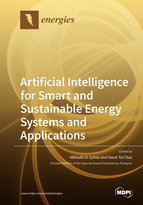Artificial Intelligence for Smart and Sustainable Energy Systems and Applications
A special issue of Energies (ISSN 1996-1073).
Deadline for manuscript submissions: closed (31 March 2019) | Viewed by 67465
Special Issue Editors
Interests: cognitive computing; artificial intelligence; data science; bioinformatics; innovation; big data research; data mining; emerging technologies; information systems; technology driven innovation; knowledge management; semantic web
Special Issues, Collections and Topics in MDPI journals
Interests: big data; bioinformatics; computational intelligence; data science; energy monitoring and management; intelligent transportation; optimization; semantic web
Special Issues, Collections and Topics in MDPI journals
Special Issue Information
Dear Colleagues,
Earth has experienced rapid climate change and global warming is important to our future. The migration from electrical grid to smart grid has been one of the crucial areas in smart city. Smart grid offers attractive advantages like carbon emission reduction, energy saving via reduction consumption, better customer service, fraud detection and demand response. Its multidisciplinary nature motivates the need for innovative and robust solutions coming from different fields of knowledge. Attributed to the complexity and abundance of data, artificial intelligence plays an important role for the success of smart grid.
This special issue aims to consolidate recent advances in artificial intelligence for smart grid, research in theory and applications. Pilot study in smart grid is especially welcome. Topics of interest for the special issue include (but are not limited to)
- New theories and applications of machine learning algorithms in smart grid
- Design, development and application of deep learning in smart grid
- Artificial intelligence in advanced metering infrastructure
- Multiobjective optimization algorithms in smart grid
- Disaggregation techniques in non-intrusive load monitoring
- Modelling and simulation (or co-simulation) in smart grid
- Internet of Things and smart grid
- Data driven analytics (descriptive, diagnostic, predictive and prescriptive) in smart grid
- Artificial intelligence techniques for security
- Fraud detection and predictive maintenance
- Demand response in smart grid
- Peak load management approach in smart grid
- Interoperability in smart grid
- Cloud computing based smart grid
- Vehicle-to-grid design, development and application
Prof. Dr. Miltiadis D. Lytras
Dr. Kwok Tai Chui
Guest Editors
Manuscript Submission Information
Manuscripts should be submitted online at www.mdpi.com by registering and logging in to this website. Once you are registered, click here to go to the submission form. Manuscripts can be submitted until the deadline. All submissions that pass pre-check are peer-reviewed. Accepted papers will be published continuously in the journal (as soon as accepted) and will be listed together on the special issue website. Research articles, review articles as well as short communications are invited. For planned papers, a title and short abstract (about 100 words) can be sent to the Editorial Office for announcement on this website.
Submitted manuscripts should not have been published previously, nor be under consideration for publication elsewhere (except conference proceedings papers). All manuscripts are thoroughly refereed through a single-blind peer-review process. A guide for authors and other relevant information for submission of manuscripts is available on the Instructions for Authors page. Energies is an international peer-reviewed open access semimonthly journal published by MDPI.
Please visit the Instructions for Authors page before submitting a manuscript. The Article Processing Charge (APC) for publication in this open access journal is 2600 CHF (Swiss Francs). Submitted papers should be well formatted and use good English. Authors may use MDPI's English editing service prior to publication or during author revisions.







